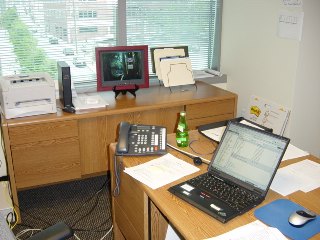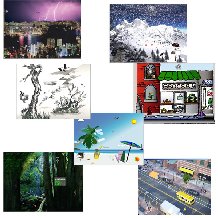
![]()
| InfoCanvas: Information Art |
Team Members: John Stasko, Dave McColgin, Todd Miller, Chris Plaue, Zach Pousman
Movie - Video overview of project (74 megabyte MPEG)
People have a great deal of personal information (financial, weather, news, traffic, communication, etc.) that they'd like to maintain awareness of, but current methods for doing so are too "heavyweight". That is, the methods use too much valuable time, as in interruptions, or space, as in desktop real estate.
We are seeking to create information awareness techniques and systems that are opportunistic, peripheral, and elegant. More specifically, we want information awareness tools to be
Personalized and consolidated - People should be able to
choose information that is personally relevant, and the display of
this information should be brought together to promote efficiency.
Elegant and peripheral - Displays of the information should
blend smoothly into a person's home or work area and enhance a
person's environment. They should not detract from other work spaces
such as the person's computer desktop.
Senstive to privacy - Displays should abstract or hide details
of sensitive personal information such as financial accounts.
 Our approach creates tools that are a form of "Information
Art." That is, we use abstract scenes or "virtual
paintings" in which the images in the scenes change subtly to
convey the state of an information resource. An individual creates
their own painting, specifying both the data of personal interest
and the images to represent that data. Our approach is similar to,
but different in important ways, from that of the PLAY Research
group's "Informative
Art" project. In their system, portions of existing
abstract artworks are modified to represent changes in data being
monitored.
Our approach creates tools that are a form of "Information
Art." That is, we use abstract scenes or "virtual
paintings" in which the images in the scenes change subtly to
convey the state of an information resource. An individual creates
their own painting, specifying both the data of personal interest
and the images to represent that data. Our approach is similar to,
but different in important ways, from that of the PLAY Research
group's "Informative
Art" project. In their system, portions of existing
abstract artworks are modified to represent changes in data being
monitored.
Our work began with an extensive survey of people's needs and wants in this area. We interviewed many people and asked about their desires to maintain awareness of personal information. We used the data gathered from that study to develop an initial concept prototype system, called the InfoCanvas. This work was reported at the AVI 2002 Conference.
 Experiences gathered from that effort helped us focus on the
InformationArt creation process. Currently, we are using an approach
that provides different painting "themes" such as a beach
scene, a rain forest, a city market, a night skyline, and an
aquarium (as shown to right). We
have created extensive sets of images (objects) for these scenes.
Each InfoCanvas scene is described through an XML file that
specifies both the information to be monitored, its graphical
representation, and the mapping from the information to the
graphical object state. The InfoCanvas is a java application that
reads this XML specification file, displays the appropriate picture,
and updates object representations in the picture as information
changes. The InfoCanvas uses data harvesters (agents that scrape
web pages) to gather the information being monitored. The system is
described in more detail in a paper at the Ubicomp 2004 Conference.
Experiences gathered from that effort helped us focus on the
InformationArt creation process. Currently, we are using an approach
that provides different painting "themes" such as a beach
scene, a rain forest, a city market, a night skyline, and an
aquarium (as shown to right). We
have created extensive sets of images (objects) for these scenes.
Each InfoCanvas scene is described through an XML file that
specifies both the information to be monitored, its graphical
representation, and the mapping from the information to the
graphical object state. The InfoCanvas is a java application that
reads this XML specification file, displays the appropriate picture,
and updates object representations in the picture as information
changes. The InfoCanvas uses data harvesters (agents that scrape
web pages) to gather the information being monitored. The system is
described in more detail in a paper at the Ubicomp 2004 Conference.
We also conducted a "glanceability" study in which we analyzed people's abilities to glance at an InfoCanvas display and digest the information being communicated. We compared a Canvas to a web portal display and a textual display of that same information, and we found that people recalled statistically significantly more information with the InfoCanvas. This study was described in a paper at the Graphics Interface 2004 Conference.
 In a longitudinal study, we deployed the InfoCanvas
to a number of trial users to run for a month in their offices in
order to understand how they use the system and what they think of
it. We conducted extensive interviews
with the participants to learn more about their impressions of the
system and how the
InfoCanvas does or does not assist with information awareness.
In a longitudinal study, we deployed the InfoCanvas
to a number of trial users to run for a month in their offices in
order to understand how they use the system and what they think of
it. We conducted extensive interviews
with the participants to learn more about their impressions of the
system and how the
InfoCanvas does or does not assist with information awareness.
Presently, we also are designing an interactive front-end tool that
will allow people to design and create their own InfoCanvases.
InfoCanvas Home | Approach | Downloads | Flash Overview | In the News